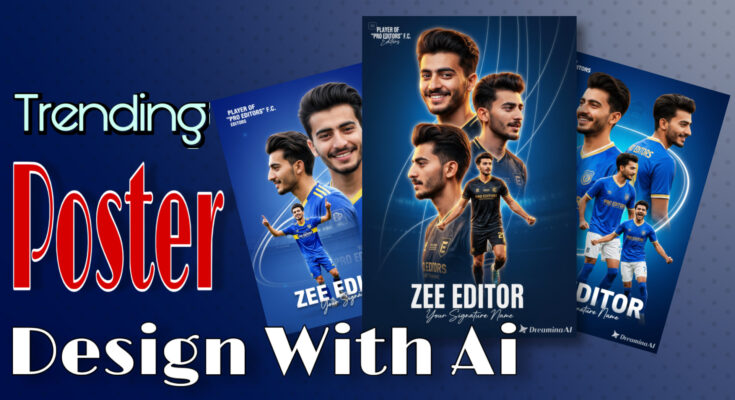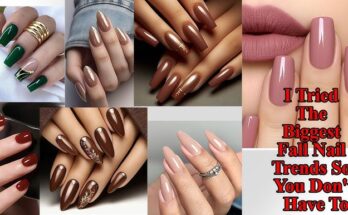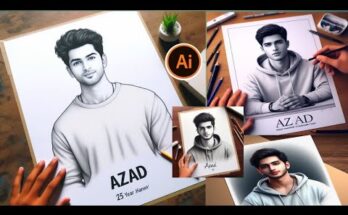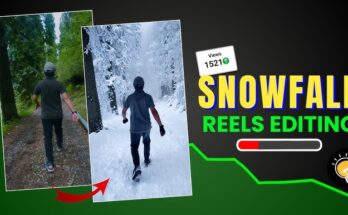Trending Football Players Banner Creation with AI
Introduction
In the digital age of sports marketing and fan engagement, creating visually striking banners featuring football players has become a key tool for clubs, brands, influencers, and fans alike. Whether it’s promoting a match, celebrating a star athlete, or launching a campaign around a player, banners are everywhere — online, on social media, and in physical stadium spaces. What’s exciting now is how Artificial Intelligence (AI) is revolutionizing how these banners are created: from generating high-quality imagery to automating layouts, and enabling non-designers to produce professional-grade graphics in minutes.
In this blog post, we’ll explore how to create banners of trending football players using AI, why this trend is gaining momentum, what tools and techniques are involved, and how you can master the process from concept to output — while keeping SEO best-practices in mind. By the end, you’ll have a full roadmap for leveraging AI for football-player banner creation (and maybe even stand out among fans or brands).
Why Trending Football Players Banners Matter
-
Fan engagement & visual appeal: When you feature top players in dynamic banner designs, you instantly catch attention. People are drawn to their favourite stars, and a well-designed banner can amplify that emotional connection.
-
Branding & commercial use: Clubs, sponsorships, merchandise, and social media campaigns increasingly rely on high-quality visuals. Banners featuring star athletes help promote merchandise drops, match announcements, and club identity.
-
Social media & viral potential: On platforms like Instagram, Twitter/X, Facebook and TikTok, banners optimized for these channels—and especially featuring trending players—can boost reach and engagement.
-
Speed & scalability with AI: Traditionally banner design required skilled graphic designers, many hours, manual layout adjustments. With AI tools, you can generate multiple versions, test designs, scale for different sizes and channels faster. For instance, platforms like Pixelcut and Pippit already offer sports-banner leveraging AI. Pixelcut+2Pippit+2
-
Customization & dynamic content: AI enables easier customization — you can change player, action pose, club colours, slogans, size, resolution, or adapt the banner for digital vs print with less manual work.
Given these advantages, it’s no surprise that banners of trending football players created via AI are becoming a go-to for marketers, content creators and fans.
Understanding the Basics: What is a Banner & Why Use AI?
What is a “banner” in the football context?
A banner is a large visual display — digital or printed — that features a message, graphics, visuals of players or teams, and is used for promotion, celebration or branding. In football, banners might be used for match announcements, trophy presentations, star‐player features, fan zones, or social posts.
Interestingly, in other football‐codes such as Australian rules, banners also refer to the giant crepe-paper ones that players run through at kickoff. Wikipedia
Advantages of using AI for banner creation
-
Speed: What took hours or days can now take minutes with the right prompt and tool.
-
Creative freedom: AI models can generate unique compositions, styles, lighting, poses—even if you don’t have a professional designer.
-
Scalability: Generate multiple variations (different players, colour schemes, layouts) quickly.
-
Accessibility: Many tools are drag-and‐drop or text-prompt based, requiring little or no design expertise.
What to watch out for
-
Licensing & image rights: Featuring famous players may require rights or usage permissions depending on context (commercial vs personal).
-
Quality control: AI may produce imagery that looks generic, odd in details (faces, proportions), so human review is still essential.
-
Brand consistency: Even when using AI, make sure you maintain consistent club colours, logos, typography, and branding guidelines.
-
Print vs digital specs: Designing for print (large banners, high resolution) vs social media (web-optimized sizes) requires different considerations.
Relevant research
For example, research in auto-banner generation frameworks shows how “Smartbanner” systems balance design freedom with rules to boost click-through rates and reduce designer effort. arXiv+1 This informs why AI tools are becoming more reliable and efficient for banner creation.
Step-by-Step Guide to Creating a Football Player Banner with AI
Here’s a detailed workflow you can follow to create your own banner featuring a trending football player:
1. Define your objective & audience
-
What is the banner for? (e.g., “Match day: Player X vs Player Y”, “Star spotlight: Player X”, “Merch drop: Player X jersey”, “Fan tribute”, etc.)
-
Who will view it? (social media followers, stadium fans, club members)
-
Where will it be used? (Instagram feed, X/Twitter banner, YouTube thumbnail, physical print, stadium signage)
-
What size/resolution is required? (for print: high resolution, e.g., 300 dpi; for social: e.g., 1080×1080 px, 1920×1080 px)
-
What message, headline, or text do you want on it? (e.g., “UNSTOPPABLE”, “GOAL MACHINE”, “Match Day Hero”, “Player X 2025”)
-
Which player(s) and which club or colours are involved?
2. Choose the right AI tool or platform
Here are some AI-powered tools you can leverage:
-
Pixelcut’s sports banner generator: lets you input details (sport, team name, colours, players) and auto-generate a design. Pixelcut
-
Pippit’s Football Banner Templates: offers editable templates with drag-and‐drop and AI enhancements. Pippit+1
-
Kapwing’s free football banner templates: good for customization on digital/social media. Kapwing
-
Custom AI image-generation tools (e.g., Stable Diffusion, DALL-E) used with prompts for unique visuals.
3. Collect assets & references
-
High-quality image(s) of the player(s) you want featured (action shot, portrait, club kit, etc.)
-
Club logos, sponsor logos (if applicable)
-
Colour palette: team primary, secondary colours, accent colours
-
Typography: decide font style (bold, modern, retro)
-
Mood/lighting references: dramatic lighting, stadium lights, cheering background, abstract gradients
-
Example banner styles you like (to guide the AI)
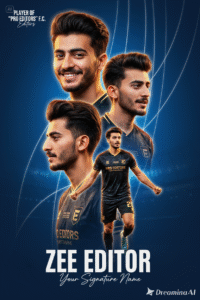
4. Create a prompt (if using text-to-image)
If you’re using a generative AI system that accepts text prompts (or hybrid text + image), craft a detailed prompt. Example:
“Create a high-resolution banner (1920×1080 px) featuring football superstar [Player Name] in an action pose (mid-kick) in front of stadium floodlights at dusk. Use the club colours [Primary Colour] and [Accent Colour]. Include bold headline text: ‘MATCH DAY HERO’. Stylise background with abstract energy streaks and light flare. The player is in full kit, sharp focus, dynamic motion blur, fans in the stands slightly out of focus, vibrant but professional look.”
You may also include negative prompts or specify “no watermark”, “print-ready”, “clean typography”, etc.
5. Generate the design & refine
-
Run the prompt in your AI tool.
-
Review generated versions: check face/pose accuracy, legibility of text, colour matching, composition.
-
Select the best version(s).
-
Adjust as needed: cropping, text placement, logos, background tweaks, colour correction.
6. Ensure brand consistency & final details
-
Insert club logo/sponsor if needed.
-
Make sure player name/spellings are correct.
-
Check colour codes match brand (hex/RGB).
-
Ensure banner works for intended size/display. For print: ensure resolution (e.g., 300 dpi), bleed/margin.
-
Check any licensing or usage rights if you’re using for commercial purposes.
-
Export in required formats: PNG for web, PDF or TIFF for print, maybe SVG if scalable.
7. Use across platforms & adapt sizes
-
Create different sizes: social feed (1:1), story (9:16), website header (16:9).
-
Consider mobile vs desktop display.
-
If printing: verify CMYK vs RGB, print proofing.
-
Use alt text and SEO metadata if posting online: “Football player banner [Player Name] 2025, match day poster”.
8. Monitor performance (if for marketing)
-
Track metrics: engagement, shares, banner click-through (if digital).
-
Ask for fan feedback: Did the banner capture attention?
-
Use the results to refine future banner designs (style, messaging, layout).
Key Design Principles for Football Player Banners
Here are some tried-and-true design principles tailored for football player banners, especially when working with AI-generated visuals:
Focus on the hero (player)
-
Make the player image dominant: large, sharp, dynamic pose.
-
Use motion blur or action streaks to convey movement.
-
Avoid clutter around the player—keep background simpler so subject stands out.
Colour & contrast
-
Use team colours prominently, but ensure contrast so text and player don’t blend into background.
-
Use accent colours for pop—e.g., neon streaks, glitch effects, light flares.
-
For print banners, ensure colours are print-friendly (CMYK safe).
Typography & hierarchy
-
Headline text (e.g., player name, slogan) should be bold, clear, legible from a distance (for stadium banners).
-
Secondary text (match details, date/time) smaller but still readable.
-
Avoid using too many font styles—stick to one or two.
-
Hierarchy: Player Name → Main Message → Date/Call-to-Action.
Visual layout & balance
-
Use the “rule of thirds” or central alignment depending on style.
-
Allow breathing space around key elements—don’t overcrowd.
-
If adding logos/sponsors, place them in less dominant corners or bottom area.
-
Consider left‐to‐right reading direction: player image on one side, text on the other.
-
Use background depth: stadium blur, light rays, motion elements to add dynamism.
Adaptability for multiple formats
-
Design with scalability in mind: banner may need to be repurposed for social, print, web.
-
Ensure key elements (player, text) are centered or safe zone for cropping differences.
-
Consider mobile safe area if using for stories.
Aesthetic consistency & branding
-
Maintain consistent style across campaigns: e.g., same font family, colour palette, graphic motifs (light flares, energy lines).
-
Use similar treatments so fans recognise the brand/club instantly.
-
If featuring multiple players or seasons, ensure branding remains consistent (even if the visuals vary).
Trends & Future Directions in Football Player Banner Creation
The rise of dynamic/animated banners
Static banners are great, but increasingly video or animated versions are gaining traction — e.g., GIFs, short loops with player motion blur, stadium lights animating. AI tools are starting to support motion/animation features.
Personalisation at scale
Clubs and brands may generate personalised banners for individual fans (e.g., “#FanName supports Player X”). AI can automate the creation of thousands of personalised banner versions quickly.
Real-time event generation
Imagine generating banners on-the-fly during live matches (goal scored → banner appears online within minutes) using AI templates and scripts.
Integration with AR/VR
With virtual stadium experiences or metaverse spaces, banners may be rendered in 3D, interactive, or viewable in VR. AI image generation + 3D modelling tools will enable this.
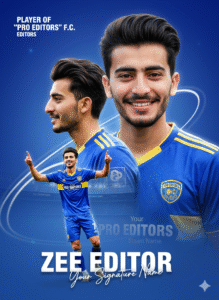
Prompt:
Ultra realistic football poster of “ZEE EDITOR” wearing the official “PRO EDITORs” kit, inspired by professional sports design. Use the uploaded image of “ZEE EDITOR” as reference for face and pose accuracy. Create a dynamic 3-player collage composition — one close-up smiling face, one side profile, and one full-body celebration pose. The background features a smooth gradient with white curved light streaks and a faint blur of “Your Stadium Name”. Text on the top left reads PLAYER OF “PRO EDITORs” F.C. with the small “EDITORs”. At the bottom, large bold text “ZEE EDITOR” appears in white capital letters with a subtle , and cursive signature text “Your Signature Name” overlaps stylishly. Lighting should be cinematic HDR with glowing edges, soft highlights, and crisp focus. The uniform is an authentic “Your Team Name” jersey with the “Your Sponsor Name” sponsor visible and “Your Jersey Number” on the back. The design follows a modern football banner style — glossy finish, vibrant tones, realistic depth of field, and professional sports magazine composition. Aspect ratio 4:5 (1080×1350), same design layout as the “Reference Poster Name”.
Generate
Call to Action
Ready to try it out? Pick your next match, select a trending player, choose your tool (Pixelcut, Pippit, etc.), and create your banner today. Then publish it to your social channels, link back to your blog/portfolio, and track how it performs. If you’d like, share the banner with me and I can give feedback or help you refine it further. Get started and let your visuals score as many goals as the players themselves!
